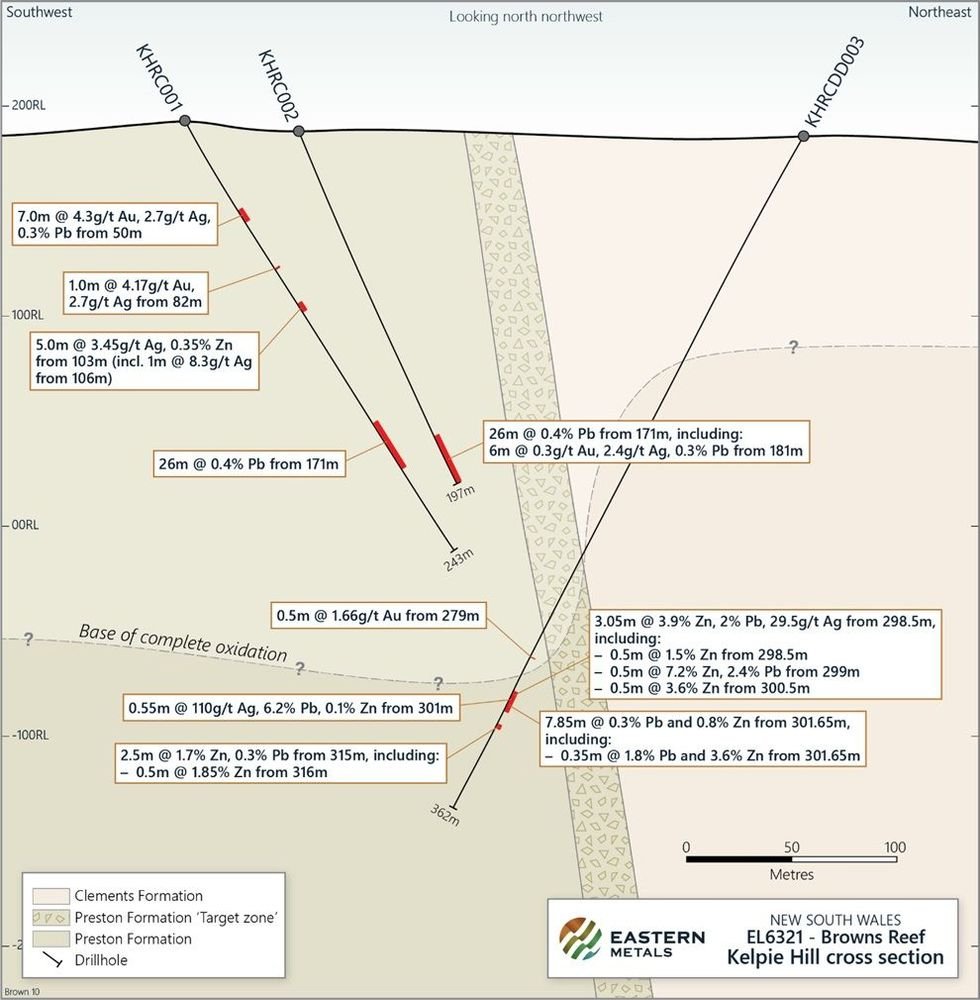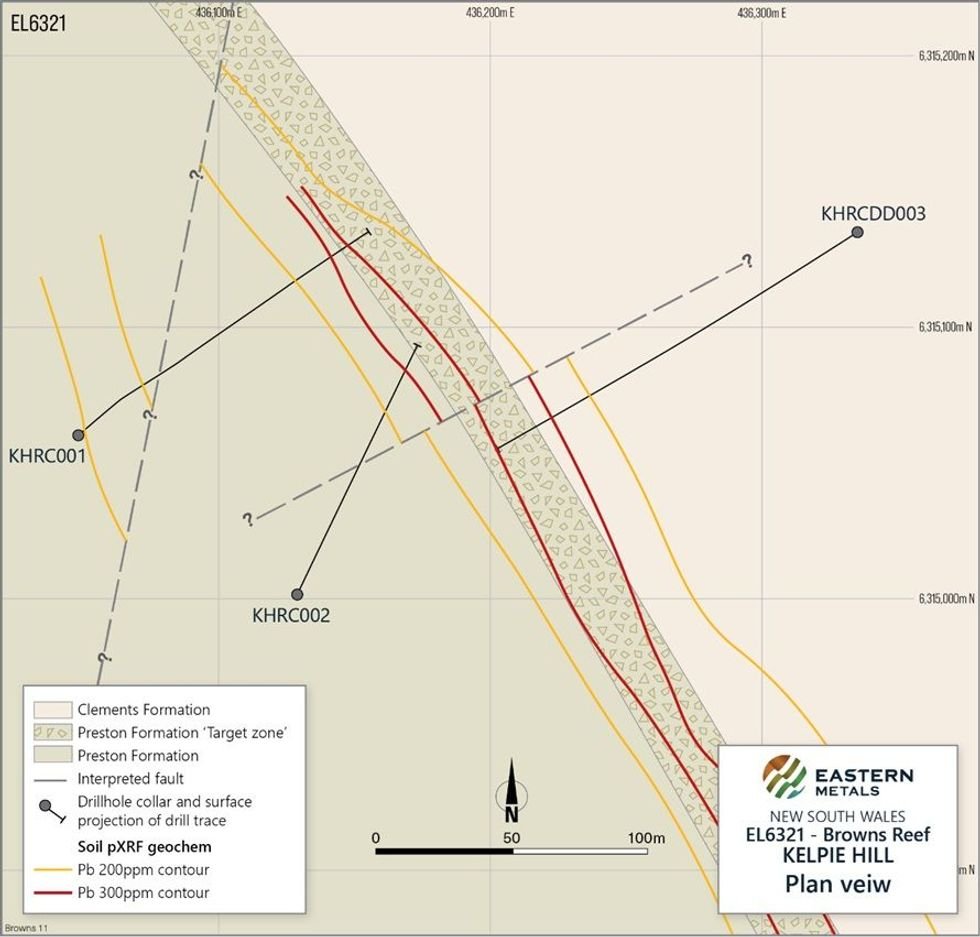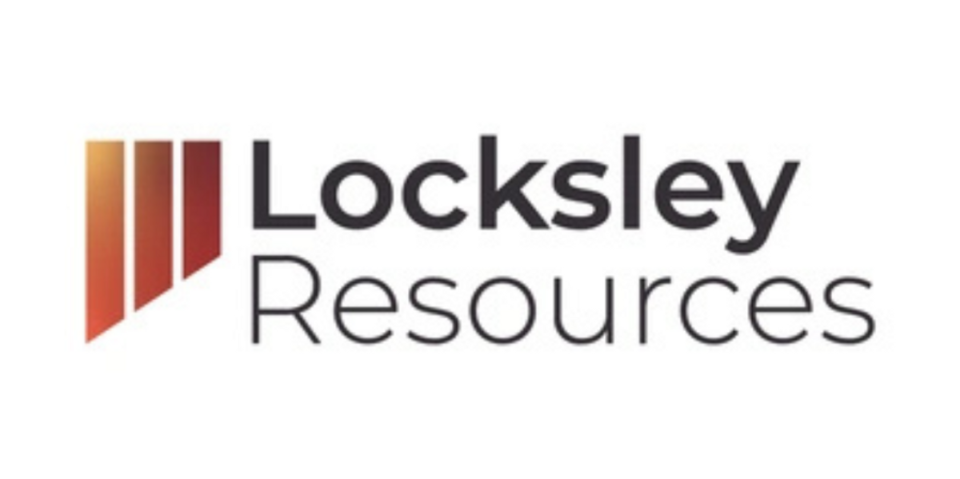- Reconnaissance drilling completed at two new targets, Kelpie Hill and Windmill Dam, and at the advanced Evergreen prospect within the 100%-owned Cobar Project in NSW.
- Assay results received for three Reverse Circulation percussion (RC) holes completed at Kelpie Hill, with hole KHRC001 intersecting significant high-grade gold plus base metal mineralisation:
- 7m @ 4.3g/t Au, 2.7g/t Ag, 0.3% Pb from 50m and 1m @ 4.17g/t Au, 2.7g/t Ag from 82m
- Holes KHRC002 and 003 intersected anomalous base metals, and were extended as diamond tails into the primary sulphide zone, returning intercepts of up to:
- 3.05m @ 3.9% Zn, 2% Pb, 29.5g/t Ag from 298.5 and 0.5m @ 7.2% Zn, 2.4% Pb from 299m
- Assays pending for two holes completed at Windmill Dam and Evergreen.
- Induced Polarisation (IP) survey due to commence in the coming weeks. Results from the IP survey will help define and prioritise targets for immediate, follow-up drill testing.
The Company has completed drilling at its two new targets, Kelpie Hill and Windmill Dam, as well as drilling at the more advanced Evergreen prospect (refer to Figure 1). Assays results have so far been received for three (3) holes at Kelpie Hill, where hole KHCRC001 returned an intercept of 7 metres at an average grade of 4.3g/t Au (incl. 1m at 8.56g/t Au) in the weathered, oxidised zone of the Preston Formation, along with silver and base metals. Refer to Table 1 for a summary of significant intercepts.
Base metal results were also returned from the other two holes, including deeper base metal zones in the primary (sulphide zone) of hole KHRCDD003. Assay results from drilling at Windmill Dam and Evergreen are still pending. In light of these highly encouraging results, the Company is finalising the design of an Induced Polarisation (IP) survey, which is due to commence in the coming weeks. Results from the IP survey will help define and prioritise targets for follow-up drill testing.
Eastern Metals’ Chief Executive Officer Ley Kingdom said: “While the high-grade gold zone intersected in the first hole was somewhat of a surprise, given that this was primarily a base metals target, intersecting significant mineralisation is an exciting development for any exploration team. While we are still in the process of evaluating the results and working out the geological context and significance of what we have seen in the first three holes at Kelpie Hill, the key takeaway for investors is that this is a highly complex, mineralised system which offers enormous discovery potential, particularly when considering how little drilling has been done. With results pending from the remaining holes, and an IP survey starting shortly, it’s definitely a case of ‘watch this space!’”.
 Figure 1: Location of EL6321 (Browns Reef) and the Kelpie Hill, Windmill Dam & Evergreen prospects.
Figure 1: Location of EL6321 (Browns Reef) and the Kelpie Hill, Windmill Dam & Evergreen prospects.
Kelpie Hill Prospect, Browns Reef (EL6321)
Three Reverse Circulation percussion (“RC”) holes were completed at the Kelpie Hill prospect for 560 metres. Two of the holes (KHRC001 and KHRC002) directly targeted a strong lead-arsenic soil geochemical anomaly, while the third (KHRC003) was drilled as a pre-collar for a planned diamond tail (KHRCDD003) to intersect the target zone at greater depth (see Figure 2).
 Figure 2: Cross-section of Kelpie Hill drill-holes KHRC001, KHRC002 and KHRCDD003 showing significant intercepts including 7m @ 4.3g/t gold (Au) from 50m downhole.
Figure 2: Cross-section of Kelpie Hill drill-holes KHRC001, KHRC002 and KHRCDD003 showing significant intercepts including 7m @ 4.3g/t gold (Au) from 50m downhole.
All three holes intersected anomalous lead-zinc gossanous ironstones, with KHRCDD003 also intersecting primary sulphides below the depth of oxidation. Diamond cored HQ “tails” were drilled to extend holes KHRC002 and KHRC003.
The 50-56 metre interval was logged by the site geologist as “massive red haematitic ironstone, gossanous” in the weathered oxidised zone of the Preston Formation to the west of the interpreted Woorara Fault, a large regional scale structure on the Preston-Clements contact. Refer to Figure 3.
Significant intercepts for KHRC001 include:
- 7m @ 4.3g/t Au, 2.7g/t Ag, 0.3% Pb from 50m, including:
- 1m @ 8.56g/t Au from 51m
- 1m @ 4.17g/t Au, 2.7g/t Ag from 82m
- 5m @ 3.45g/t Ag, 0.35% Zn from 103m, including:
- 1m @ 8.3g/t Ag from 106m
 Figure 3: Kelpie Hill plan view of drillholes KHRC001, KHRC002 and KHRCDD003 with Pb soil contours, and interpreted faults.
Figure 3: Kelpie Hill plan view of drillholes KHRC001, KHRC002 and KHRCDD003 with Pb soil contours, and interpreted faults.
Hole KHRC002 was extended as hole KHRCDD002 with a diamond cored tail from 197 metres to 201.35 metres; however, this hole was abandoned due to drilling complications and did not reach the planned target depth into the Clements Formation on the eastern side of the target zone.
The oxide zone interval 169 to 197 metres is strongly lead anomalous, with the interval 175.5 to 197 metres logged by the site geologist as “strongly silica altered ex-shale and sandstone, often highly ferruginous to gossanous, limonite and haematite stain, pits ex-sulphide, quartz veins”.
Click here for the full ASX Release
This article includes content from Eastern Metals, licensed for the purpose of publishing on Investing News Australia. This article does not constitute financial product advice. It is your responsibility to perform proper due diligence before acting upon any information provided here. Please refer to our full disclaimer here.

